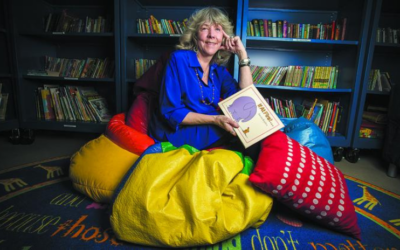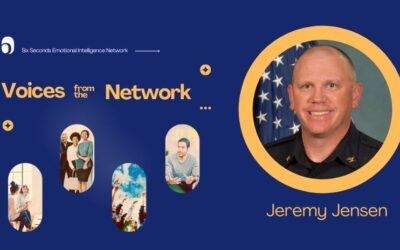“If one person had opened up and I had heard their story, I would not have suffered so much,” Kessenich says. “And that’s what motivates me to do this work.”
Courtney Kessenich has struggled with anxiety her entire life. As Mrs. DC International, she uses her platform to promote her Hope for Invisible Wounds initiative, which aims to break the stigma around anxiety and inspire others to get the help they need. Kessenich offers herself as an example that, no matter how much someone is suffering, they can overcome.
Healing Invisible Wounds:
Mrs. DC International and EQ Ambassador Courtney Kessenich Opens Up About Her Struggles with Anxiety and Breaking the Stigma of Seeking Care
‘I Thought It Was Normal’
Kessenich started dealing with anxiety following multiple childhood traumas. She lost both of her parents young, and her mom’s death, after a multi-year fight with cancer, hit Kessenich particularly hard. She was just seven when her mom passed away. Her stepmom, instead of proving love, support and stability in the aftermath of her mom’s death, physically and emotionally abused her. Then, just after grad school, she lost her father to alcoholism and mental illness. This struck her to her core.
“When it started, I couldn’t identify it,” Kessenich says, “I would stay up all night worrying about something at school the next day, or think my friends or teachers were talking about me. I thought it was normal. But when I lost my dad, I had my first panic attack. I ultimately had no choice but to face my illness.”
The scary part about anxiety in general is that it has become normalized – as a lived experience if not yet a topic of conversation. In the United States alone, an estimated 40 million adults suffer from some sort of anxiety disorder. And even though it’s highly treatable, only about 36% seek treatment. One reason: the stigma associated with mental illness. People continue to suffer in silence rather than seeking help. Since getting care and finding healthy coping mechanisms herself, Kessenich has made it her mission to break this vicious cycle.
‘One of the Things That Changed My Life’
For Kessenich, finding stability in healthy coping mechanisms and a strong support system was key. Finding a way to shut off her brain is the one thing that changed her life. “One of the worst symptoms of my anxiety is spinning thoughts,” she explains. “And I couldn’t find a way to shut my brain off. I would lie awake at night reliving conversations that I had had with someone five years ago. Once I found spin class, I found a way to turn the spigot off — for 45-minutes at least. It’s one of the things that I credit with getting my life back.” Spin classes are now part of her routine mental health maintenance.
Discovering spin is a great example of how Kessenich has used emotional intelligence to treat her anxiety, specifically the Choose Yourself part of the Six Seconds Model of EQ. Choose Yourself is about realizing you have choices and doing what you mean to do instead of reacting on autopilot. Kessenich realized she could turn the spigot off, and that it helped her feel better.
Just because it works for her, though, she stresses that it doesn’t mean that it will work for everyone. “There is no one-size-fits-all solution,” she says. “My friend loves equine therapy, retreats with horses. For me, that would be a huge trigger because I used to ride horses with my dad. But for her, it’s part of her healing. In addition to spin, diet is also a big part for me. Other people I know swear by meditation, running, or yoga. You have to find what works for you.” Choose Yourself is about realizing you have options and trying them on for size.
But according to Kessenich, nothing has been as transformative as the last part of the Six Seconds Model of EQ, Give Yourself.
Give Yourself is about connecting with others and your bigger purpose. A growing body of evidence indicates that connection is the ultimate antidote to anxiety, and that has definitely been true for Kessenich. “So much of my healing has come through helping others,” she says. “It lowers my anxiety in profound ways.”
Thankfully, as Mrs. DC International, Kessenich has an amazing platform to spread her message and help others. “The reason I do pageants is because it provides me with a platform to help others by sharing my story. Through that megaphone, I can reach those going through similar struggles and help them know that if I can find a way, so can they! ”
Check out the amazing work she’s doing to help break the stigma and connecting people with resources to heal:
Giving a Voice to Others
Kessenich shares stories of healing on her blog, Spinning Through Life, from those around the world who have struggled with mental illness and have overcome. This provides a way to help break the stigma by showing those who once struggled now thriving after seeking care. “I’m helping give a voice and platform to help spread messages of healing around the world,” she says, “and hopefully someone can relate to it and know there is help available.”
Connecting with Resources
Kessenich runs a mental health initiative, Hope for Invisible Wounds, where she shares information about mental health, seeking care and resources for feeling whole. You can follow the page and share the information to help support awareness for invisible wounds and changing the stigma around seeking care on Facebook and Instagram
Advocating to Save Lives
Kessenich has partnered with the global organization World Federation for Mental Health to work to implement a suicide prevention plan in every country worldwide by working to fundraise, advocating for legislation and continuing to raise awareness.
Kessenich will be competing for Mrs. International 2019on July 15-21 in Charleston, West Virginia, USA as Mrs. DC International. She’ll be promoting her Hope for Invisible Wounds platform and hopefully, if she wins, receive support to expand her programs worldwide. Good luck, Courtney, and thank you for sharing your story and your amazing work to promote emotional wellbeing!
What’s new in emotional intelligence?
Emotional Intelligence at Work: The Free, Easy Win Most Managers Are Missing
Gallup study compares the biggest gaps in employee vs. manager perceptions. What are managers’ worst blind spots? What are easy wins they could do better to improve team performance?
Is Boredom Bad for Kids? Emotional Intelligence Education News
Let’s unpack boredom and how emotional intelligence can help you with tips to support bored children (and keep your cool!). Keep reading for EQ research and resources you can use for you, your faculty and students.
Effective Emotional Intelligence Coaching: 4 Questions to Improve Client Outcomes with Social and Cultural Insights on Emotions
Improve your emotional intelligence coaching by understanding the social and cultural influences on emotions. Ask these 4 key questions for more effective client relationships
Krish and Anabel: SEL Pioneer and Mentee Share 6 Life Lessons on Empathy, Integrity, and Emotional Intelligence
What are 6 life lessons you’ve learned? Dr. Anabel Jensen, SEL pioneer and Six Seconds President, explores this important question with her 16-year-old mentee.
Voices from the Network: Jeremy Jensen
In this Voices from the Network, we sit down with Police Chief Jeremy Jensen, who is doing emotional intelligence training with his officers in Dubuque, Iowa.
Emotional Intelligence at Work: Is There Hope for Toxic Workplaces?
The remarkable transformation at Westcomm Pump offers a blueprint for turning around workplaces with depleted morale and trust issues, using the Team Vital Signs assessment.
- Pursue Noble Goals in the Six Seconds Model of EQ - July 29, 2023
- Increase Empathy in the Six Seconds Model of EQ - July 26, 2023
- Exercise Optimism - July 24, 2023











I loved this article!
Thank you, Cheryl!